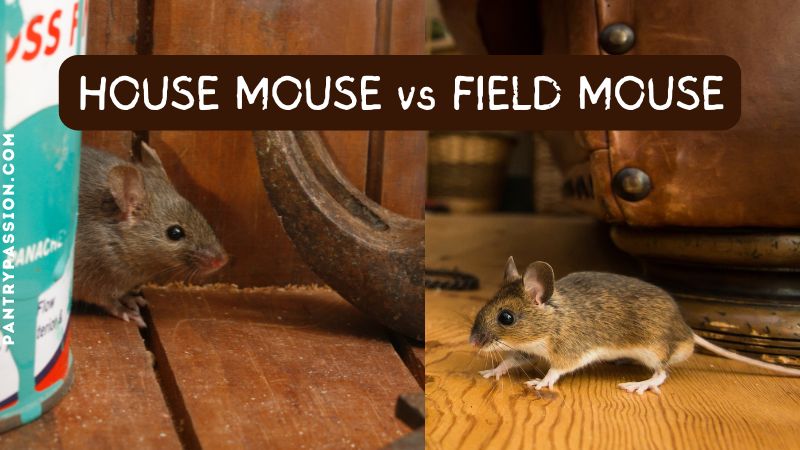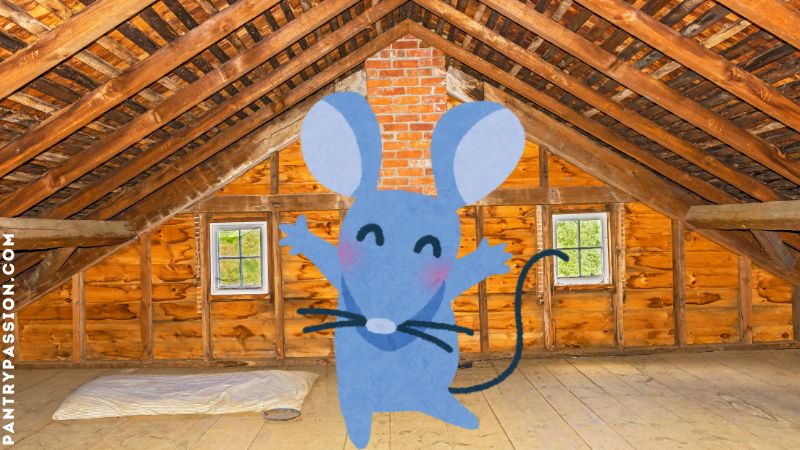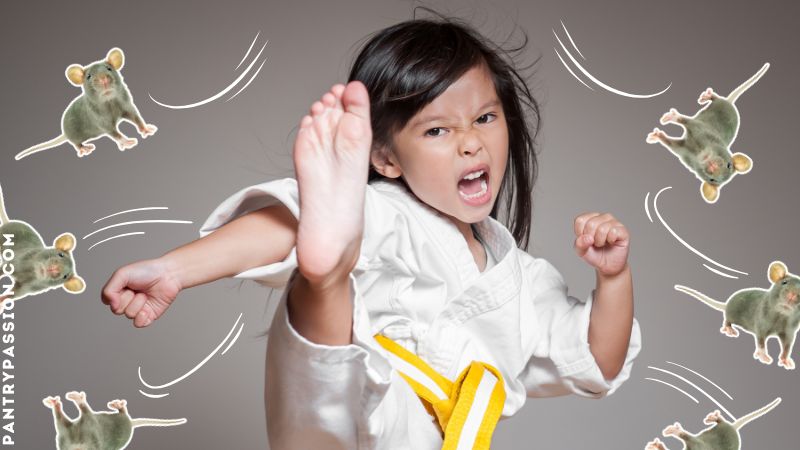The Best Fluffy Pancakes recipe you will fall in love with. Full of tips and tricks to help you make the best pancakes.
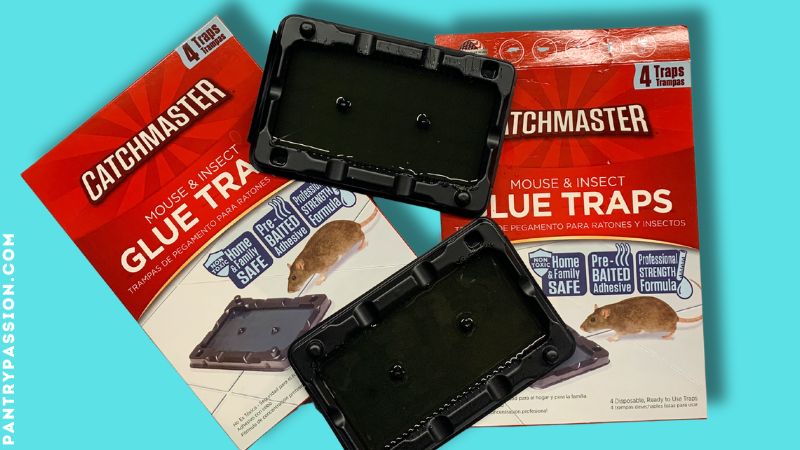
In this post, we’ll explore how glue mouse traps work, why they’re favored by some and frowned upon by others, and what you need to know before placing one under your kitchen sink. Whether you’re battling a full-blown infestation or just spotted a single intruder, understanding the pros, cons, and humane alternatives can help you make the smartest—and kindest—choice for your home.
DON’T MISS Pantry Passion’s Complete Article List for Mouse & Rat Prevention!
Table of Contents
- Catching Mice With Glue Traps: What Works, What Doesn’t
- How Sticky Traps Kill Mice
- How to Get a Mouse Off of a Glue Trap
- Why Do Some Mice Avoid Glue Traps?
- How to Remove Mouse Trap Glue From Dogs & Cats
- How to Get Mouse Trap Glue off of Floors, Carpet, Fabrics, Clothing, Shoes & Skin
Catching Mice With Glue Traps: What Works, What Doesn’t
My preferred mouse trap of choice is mouse snap traps. When this fails, it means the mouse is too smart – then it’s time for the sticky glue traps. Like any pest control method, there’s a bit of strategy involved.
To be clear, glue traps are most effective if you put them at choke points of the rodent’s preferred travel paths. In addition, remove all food sources and bait the trap with a tiny bit of peanut butter.
Glue Trap Types
The most typical standard of glue traps are glue trap trays. However, you can get glue traps that fold into a box shape. These are ideal to place along popular rodent runways like baseboards in homes. They also offer a cozy, sheltered place that mice love.
Do glue traps work? Yes.
I resort to them when I have a mouse that seems to be avoiding capture. It’s usually the “dirty mice” (what my husband refers to the house mice as) that are the super evasive ones. House mice (not country or field mice) can be very hard to trap. I don’t know if they are super mice, or what, but they can be immune to traditional mouse traps.
Traditional mouse traps kill instantly – they are humane, despite what you think. If I detect a mouse problem, and I haven’t successfully caught the mouse within a day or two, or the mouse trap has been tripped, the sticky traps come out.
Bulk Rodent Trap Glue: A Last Resort
You can also buy Catchmaster rodent glue in bulk. This is what the pros do because it’s way more economical than buying small individual glue traps. The advantage: make any size or shape of sticky trap you desire, such as using cheap baking sheets/trays from thrift stores with a half-inch or more rim.
The problem is, patience is required. Users state that they have to take an extra step to melt the solid into a liquid. Know that this is not for everyone, many will give up because of the mess and extra effort involved.
User’s agree, it’s messy to work with! They recommend:
- Take a few bits out and warm in a preheated oven or old crockpot with some water in it to increase spread-ability.
- Cut small bits with scissors or heated butter knife.
- Use a heat gun to melt it down and apply it to a piece of cardboard or piece of wooden board.
- Set in hot vehicle in the summer sun.
- Melt the whole can over a gas stove burner turned as low as it goes… it takes a while. an electric stove can be turned low enough… you don’t want to burn it.
- The melted glue has the consistency of latex paint, and solidifies quickly as it is poured (tip: blast with heat gun to spread further on cookie sheet).
- Use a cheap plastic soup ladle that you won’t need for anything else to transfer it to the baking sheets.
From Amazon user FA: “Big sheets work best for big rats. When it traps one, you will hear it squeeking. Kill it… place whole tray in a tub of water, or whack it in the head. Use a disposible glove, slowly peel the rodent off the glue (usually by holding the tail) and dispose of the carcass. This way you can reuse the trap many times, until so much glue has been removed that you need to add more. Just try to place your glue traps in locations with a minimum of loose material around them… straw, leaves, trash, etc…. so stuff doesn’t blow or get kicked onto the glue. Works great in barns, sheds, etc. I’ve caught about thirty rats and some mice already this way.”
How Glue Traps Actually Catch Mice
Glue traps work by using a sticky adhesive surface to immobilize rodents when they step on it. They’re easy to place behind furniture, under sinks, or near walls — spots mice love to travel. But placement is everything: mice tend to run along edges rather than across open spaces, so you’ll want to set traps where mouse droppings or gnaw marks show activity.
This is a sick thought: mice stuck on glue traps are usually eaten by other mice that use the bodies to avoid the glue. Reddit user karlnite offered that insight.
Where to Place Mouse Glue Traps
Glue trap trays are perfect for low-profile locations, like under a sofa or piece of furniture. These are other common hiding spots mice adore. The picture below is from a Catchmaster box that encourages placement along baseboards, under sinks, and along toe kicks of kitchen cabinets.
Other advice from Twin Home Experts is to NOT place randomly. “Mice want to get from point A to point B FAST. Put the glue in the center of their highway [paths like baseboards]”.
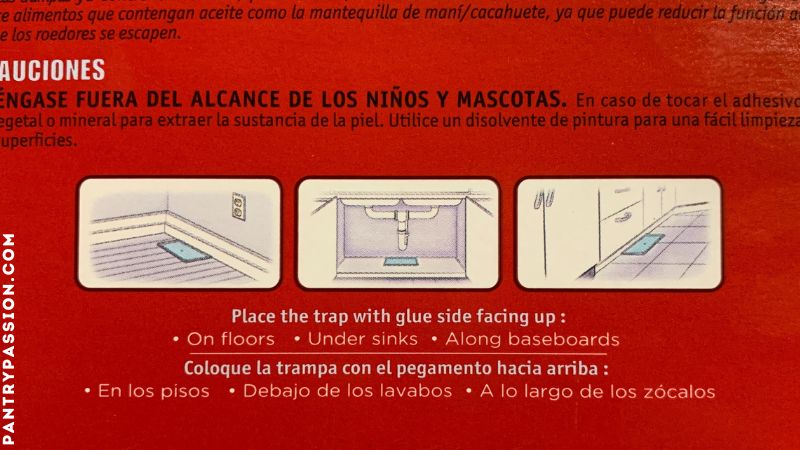
Can Mice Get Off Glue Traps?
Surprisingly, yes — if the adhesive starts to dry out or lose tackiness, a mouse might struggle free, leaving some fur behind. Larger or stronger mice may also drag the trap, especially if it’s lightweight. If fur, dust or insects already cover the glue, it loses grip quickly. That’s why it’s important to:
- Use fresh traps
- Place traps flat on solid surfaces
- Monitor and replace them regularly
How Long Do Glue Traps Last?
It may be possible that you have to toss out a glue trap without catching a mouse. As stated previously, if fur, dust or insects already cover the glue, it loses grip quickly. Glue traps work, but not very well this way. Most people will agree that glue traps are expensive for one-time use. That’s why the professionals use Catchmaster bulk glue (I discuss the caveats of this later in the article).
Glue traps are usually packaged in packs of two, facing each other and you pry them apart (with gloves on – remember, don’t leave a human scent!). If you don’t think you will use one of the sticky traps, place a greased cover on it, like vegetable oil sprayed onto wax paper, and cover the surface and stick in a Ziplock bag to extend the life of it.
Glue traps don’t work well in dusty, dirty places. I had a glue trap in a back cellar that quickly filled up with insects – not mice. The same goes for dusty garages. This debris leaves the glue trap unable to catch mice.
If you do have to throw it away, dispose of it in the same manner as if it had a dead mouse on it: toss it in a bag and tie a knot shut, then into your main trash.
Best Bait for Mouse Glue Traps
Glue traps don’t technically need bait, but adding a tempting lure helps draw mice to the right spot. Although peanut butter is a top choice for mouse food bait, avoid it here. In fact, avoid any oil-based foods, it will only assist the mouse escaping the glue trap.
According to Twin Home Experts you want to use scented glue traps for mice, and unscented glue traps for rats.
If you choose to add additional bait, do not use oil based foods such as peanut butter as this will degrade the adhesive and allow rodents to escape.
Instructions from Catchmaster glue trap product box
Instead, use these types of bait on glue traps:
- Chocolate chips: Rich scent that attracts mice.
- Oats or granola: Crumbly textures they’re drawn to.
- Sunflower seeds: Small and enticing.
- Fluffy batting: Some mice are in it for the nest material.
- Dog food: especially for rats. Mice go for both cat and dog food.
Add a tiny bit of bait at the center of the glue trap (not too close to the edges), and you’ll increase the chances of a catch. For my mega-list of mouse food bait, visit Good Bait for Mouse Traps.
Also understand that most glue traps come with their own scent or attractant (usually peanut butter), making it unnecessary to bait the glue trap. Speaking of scent, always handle the traps with nitrile gloves so you don’t transfer human scent/oils to the trap (pretty much wasting your time if human contact happens).
How Sticky Traps Kill Mice
Sticky traps don’t always result in dead mice. They work by immobilizing the mouse when it steps onto the adhesive surface. Once stuck, the mouse can’t escape, and death usually occurs. The mice or rats may escape or run off with the trap stuck to them. When this happens, no one knows the outcome.
Here is what brings death to a rodent stuck to a rat glue trap or mouse glue trap:
- Exhaustion: The mouse struggles until it becomes too weak to move.
- Suffocation: The mouse may stick its face to the glue trap, resulting in suffocation.
- Mouse dies from heart attack from effort to escape the glue.
- Starvation or dehydration: If not found quickly, the mouse may die over hours or even days.
- Hypothermia: In cooler environments, trapped mice may lose body heat and die from exposure.
If you have chosen to place some poison on the trap, I doubt it will aid in killing the mouse. The mouse will likely be too distressed to be interested in eating it.
Do Glue Mouse Traps Have Poison?
Glue mouse traps do not have poison. When your pets accidentally get into the sticky trap, you can feel safe knowing that glue traps are not poisonous nor toxic to dogs or cats, or humans for that matter
However, some people may up their mouse-catching game by placing a few poison mouse pellets on the glue. This is completely optional.
How Long Can a Mouse Live On a Glue Trap?
A mouse caught on a glue trap can survive anywhere from a few hours to over 24 hours, depending on several factors like stress, dehydration, and exhaustion. Here’s what typically happens:
- Most mice die within this window due to lack of food, water, and the physical toll of struggling.
- Prolonged suffering: If not checked promptly, the mouse may endure significant distress before death.
Are Glue Traps Inhumane & Cruel?
Even the toughest farm folks don’t like to come up to a glue trap with a struggling mouse stuck to it. If you’re lucky, the mouse will be dead, but most people don’t have the guts to deal with a live mouse.
In researching this article, I’ve come across many sincere posts in forums of people begging users not to use glue traps for these reasons:
- Slow, painful death: Many consider glue traps inhumane because they prolong suffering.
- Visible distress: Mice often cry out or chew off limbs trying to escape.
- Risk to pets and children: Sticky traps can accidentally catch non-target animals.
- Effectiveness drops over time: Dust, dirt, or humidity can reduce stickiness.
If you’re using mouse glue traps and are worried about any suffering on the rat or mouse’s part, you need to check the traps routinely so you do NOT leave one suffering. If it isn’t dead, killing the rat or mouse quickly is considered the most humane thing to do.
Alternatives to Consider
| Trap Type | Kill Speed | Humane? | Reusable? | Pet Safe? |
|---|---|---|---|---|
| Snap Trap | Instant | ✅ Yes | ✅ Yes | ⚠️ Use with care |
| Electric Trap | Instant | ✅ Yes | ✅ Yes | ✅ Often enclosed |
| Live Trap | No kill | ✅ Yes | ✅ Yes | ✅ Yes |
How to Get a Mouse Off of a Glue Trap
This is why I would much rather prefer a traditional mouse snap trap. Disposing of mouse glue traps—whether they’ve caught a rodent or not—requires care, cleanliness, and a touch of compassion. You have two options—release or euthanize humanely.
If the Mouse Is Dead
- Use thick gloves and flip a plastic bag inside out over your hand.
- Grab the glue trap and mouse together, then roll the bag back over and seal it.
- Dispose of it in your outdoor garbage bin.
- How to Clean-Up a Dead Mouse in a Trap walks through proper sanitation steps to minimize health risks like hantavirus.
How to Kill a Mouse On a Glue Trap
Refer to my article on how to kill mice that will give options for how to kill mice on glue trap. Killing a mouse quickly on a glue trap includes the main options of blunt force blow to the head or drowning.
Bonus: Step-By-Step How to Free Mouse From a Glue Trap
There are some of you with big hearts out there who will want to remove a live mouse from a glue trap. Holy cow, that is NOT me. OK people, if you put the glue trap into use, there are consequences. If you’re not ready to kill the mouse, then DON’T USE THE STICKY TRAP.
But let’s say you have come across the glue trap at a friend’s house, or maybe the trap has baby mice in it and you think, “Dear Lord – what have I done?” The following is for you:
- Apply vegetable oil to the glue to loosen it.
- Gently work the mouse free using a cotton swab or cloth.
- Release it at least 2 miles away from your home to prevent return (as your neighbor, I will SO not be happy with you when the mouse shows up at my house!).
- How to Release a Mouse From a Glue Trap. shows how a few drops of oil can free the mouse instantly.
- HOW TO SAFELY REMOVE A BABY MICE FROM STICKY TRAP offers a gentle approach for younger or more fragile mice.
- How To Remove a Mouse From a Glue Trap emphasizes safe handling and minimizing stress to the animal.
Why Do Some Mice Avoid Glue Traps?
Mice aren’t always easily fooled. They can be cautious of unfamiliar objects, especially if:
- The glue trap has a strong chemical smell
- The glue trap is stored where it absorbs other adverse odors
- Placement interrupts their usual path
- They’ve encountered it before and survived
To increase effectiveness:
- Rotate bait and placement strategies every few days
- Wear gloves when placing glue traps to avoid human scent
- Use multiple glue traps at once along active paths (refer to advice in my mouse trap strategy article)
Solutions Pest & Lawn Youtube video on glue trap mistakes, states that mice are cautious creatures that avoid newer things in their environment for quite some time. There is actually a name for this condition, called neophobia. I explain this in my article on strategy for setting snap traps.
Solutions Pest & Lawn recommends setting multiple glue traps 2-3 feet apart to increase the effectiveness and chances of catching mice. Adding more glue traps helps to normalize the presence of them.
How to Remove Mouse Trap Glue From Dogs & Cats
Getting mouse trap glue off your dog can be tricky, but with patience and the right approach, you can safely remove it without harming your pup’s skin or fur. Here’s a step-by-step guide, supported by expert video tutorials:
🧼 Step-by-Step Removal Guide
- Stay Calm and Restrain Gently
- Your dog or cat may be scared or uncomfortable. Speak soothingly and gently restrain them to prevent sudden movements.
- How Can We Remove Trap Glue From The Dog’s Fur? shows a real-life rescue and emphasizes the importance of staying calm and gentle throughout the process.
- Use a Safe Oil-Based Product
- Apply vegetable oil, baby oil, coconut oil, or even cooking spray to the glue-covered fur. These help break down the adhesive.
- Let it sit for a few minutes to soften the glue.
- Glue Trap Removal explains how oils act as solvents and demonstrates their effectiveness in loosening glue.
- Gently Work Through the Fur
- Use a comb or your fingers to slowly and gently work the glue out of the fur.
- Avoid pulling or tugging—go slowly to prevent pain or skin damage.
- STICKY GLUE ON DOG | How to Remove offers a clear visual of this process and shows how to avoid hurting your dog.
- Clean and Rinse
- Once the glue is removed, wash the area with pet-safe shampoo and warm water to remove any residue.
- How to Remove a Pet from a Glue Board walks through the full cleanup process, including rinsing and drying.
- Check for Irritation
- Inspect the skin for redness or irritation. If you notice anything concerning, contact your vet.
- What to do if Animal stuck in Glue Trap or Fly Paper, Puppy … highlights the risks of prolonged glue exposure and why aftercare matters.
🐾 Bonus Tip
If your dog or cat got stuck to the glue trap itself (not just the glue), you may need to carefully cut away parts of the trap. How to Release a Mouse From a Glue Trap shows how oil can help release stuck limbs without injury—use the same principle for pets.
If the glue is in sensitive areas (like around the eyes or mouth), or if your pet is in distress, don’t hesitate to call your vet.
How to remove mouse trap glue is a very common question. You really have to know what you’re getting into once you make up your mind to use sticky straps. The glue can get on you, your clothes, your hair, the floor, and your curious pets.
How to Get Mouse Trap Glue off of Floors, Carpet, Fabrics, Clothing, Shoes & Skin
Getting mouse trap glue off these surfaces can be a sticky situation—but with the right approach, you can clean it up without damaging fibers, human skin or surfaces like furniture. Here’s a step-by-step guide, backed by real-life demos and expert tips from video tutorials:
In case of contact with adhesive, use vegetable or mineral oil to remove from skin. Use paint thinner for easy clean up on floors and other surfaces.
Instructions from Catchmaster glue trap product box
🧽 Step-by-Step Carpet Glue Removal
- Act Quickly
- The sooner you treat the glue, the easier it is to remove. Letting it sit can cause deeper staining or fiber damage.
- Scrape Off Excess Glue
- Use a spoon or dull butter knife to gently lift as much glue as possible.
- How to remove sticky mouse trap glue from your carpet … shows how to do this safely while avoiding damage to the carpet pile.
- Apply an Oil-Based Solvent
- Dab vegetable oil, baby oil, mineral oil, cooking spray, or WD-40 onto the glue spot to break down the adhesive.
- Glue Trap Removal explains how oils act as solvents and demonstrates their effectiveness on sticky traps.
- Blot and Lift
- Use paper towels or a lint roller to blot the area and lift softened glue.
- Effective Glue Removal Techniques for Carpet and Fabrics shows how to use a fabric steamer and scraper to gently lift residue without harming carpet fibers.
- Deep Clean the Spot
- Wash the area with warm soapy water or white vinegar to remove oily residue.
- Removing Carpet Stains & Spots : How to Remove Glue From … demonstrates how to blot with vinegar and rinse between applications for a thorough clean.
- Vacuum and Finish
- Once dry, vacuum the area to restore texture and remove any remaining particles.
- How to Remove Glue from Carpet Efficiently emphasizes aggressive vacuuming and scraping to lift stubborn glue remnants.
🧼 Bonus Tip: Clothing Mishaps
If glue transferred to your clothes during cleanup, HOW TO REMOVE MOUSE TRAP GLUE FROM CLOTHING offers practical advice for salvaging fabric without leaving stains or residue.




